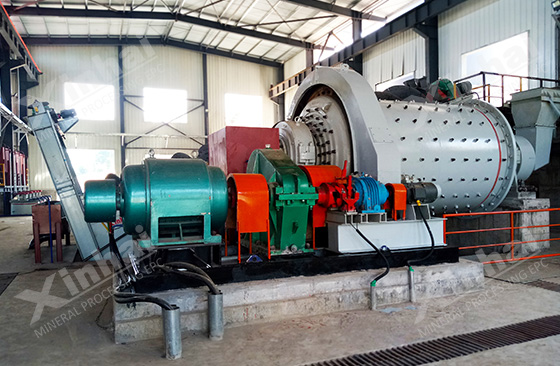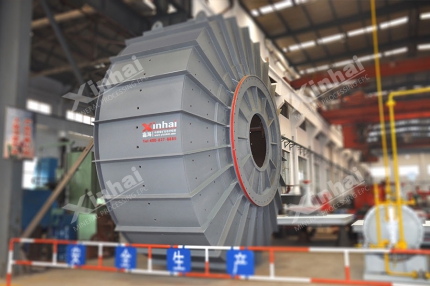The grinding process of a phosphate ore dressing plant generally forms a closed circuit with the classifier or hydrocyclone. Phosphate rock grinding can adopt one-stage grinding or stage grinding. The number of grinding stages and processes generally need to be determined based on the characteristics of the phosphate ore, the requirements of the concentrate product, and the production capacity. Siliceous apatite has medium hardness and coarse dispersion particle size, so it can adopt a one-stage grinding process. However, when processing colloidal phosphate ore, the product particle size is required to be fine and the productivity is high, so it is necessary to increase the number of grinding stages. Therefore, different types of phosphate rocks use different grinding processes. The following will introduce you to the grinding processes of four types of phosphate ores.

Commonly used processes for grinding include: one-stage closed-circuit process, one-stage closed-circuit process with pre-grading, one-stage closed-circuit process with controlled grading, two-end closed-circuit process and two-stage fully closed-circuit process. Among them, the one-stage closed-circuit grinding process with inspection and classification is relatively simple and is widely used in phosphorus processing plants. Because inspection and classification can control the particle size of the grinding products and ensure the flotation effect. At the same time, checking the classification can also increase the amount of ore fed into the ball mill, shorten the time for the ore to pass through the ball mill, reduce over-crushing and improve the grinding efficiency.
The selection of the grinding process should be determined based on the particle size of the ore feed and the particle size of the concentrate product. The first-stage grinding process is relatively simple and easy to configure. Its infrastructure cost is low and it is easy to manage. When the grinding ratio is large and the product particle size is required to be fine, you can choose two-stage grinding to obtain a product with good quality, uniform particle size and less muddying problems.

According to the disseminated particle size characteristics of phosphorus-containing minerals and gangue minerals, phosphate rock can be divided into four major categories: coarse-grained phosphate rock, medium-grained phosphate rock, fine-grained phosphate rock and complex disseminated phosphate rock. of phosphate rock.
Use the table of contents below to navigate through the guide:
01Coarse-grained phosphate ores
Coarse-grained phosphate rock generally refers to crystalline apatite ore, and the disseminated particle size of phosphorus-containing minerals is 0.3-0.4mm. When grinding, it is necessary to ensure that the phosphorus-containing minerals are fully dissociated and to meet the particle size required for flotation. Coarse grinding and rough separation are required. During the grinding and flotation processes, over-crushing should be avoided, which is of great significance to reducing grinding costs, improving mineral processing indicators and processing of concentrate products. The coarse-grained phosphate rock can complete the basic dissociation of phosphorus-containing minerals after a period of grinding. The specific grinding fineness needs to be determined based on the mineral processing test results and production requirements.

02Medium-grained phosphate ores
The particle size range of medium-grained phosphate rock is generally 0.1-0.2mm. When processing this kind of ore, a grinding process is generally selected, and the specific grinding fineness needs to be determined based on the ore dressing test results. The primary grinding process can basically dissociate phosphorus-containing minerals. During the grinding process, care should be taken to prevent over-grinding. After the phosphorus-containing minerals are fully dissociated, flotation is carried out at a coarser particle size, which can reduce grinding costs and improve mineral processing indicators. It is also conducive to the concentration and filtration of concentrates.
03Fine-grained phosphate ores
The dissipation particle size of 0.05-0.1mm is called fine-grained disseminated phosphate rock. Generally, colloidal phosphate rock or fine-grained apatite belongs to this kind of ore. When grinding ore, the ore needs to be ground to a very fine particle size in order to fully dissociate the phosphorus-containing minerals. However, it is worth noting that grinding to a very fine particle size at one time will cause the brittle ore to become muddy, thus affecting the flotation process. Therefore, this type of ore is generally processed by stage grinding and stage flotation processes.

04Complexly dyed phosphate ores
The dissipation particle size of this type of ore is generally uneven, and the dissociated particle size of the mineral needs to be carefully studied. Considering technology and economy, you can choose the grinding and grading process. Of course, you also need to pay attention to the mud problem caused by excessive grinding, and the dissociated minerals should be recovered in time. Stage grinding and stage flotation processes can also be used to process this kind of ore.
The above is a brief explanation of the four phosphate ores grinding processes. The specific grinding process and number of stages should be determined based on the results of the mineral processing test. A suitable grinding process can not only improve grinding efficiency and reduce ball mill wear, but also improve the efficiency of subsequent phosphate ores separation, ensuring full utilization of ore resources while increasing economic returns.


 marketing@ytxinhai.com
marketing@ytxinhai.com  0086 13810327080
0086 13810327080 






































































































 CHAT
CHAT MESSAGE
MESSAGE





